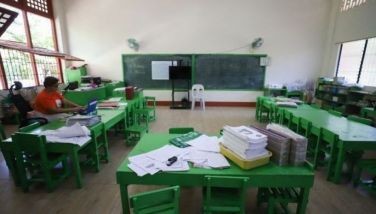Discovery video backs Abenojar conquest
February 19, 2007 | 12:00am
Filipino adventurer Dale Abenojar said documentary producer Discovery Channel has a 30-minute video footage of him and other mountaineers on Mt. Everest on May 15 last year, or days ahead of the two other Filipino climbers who were officially acknowledged as the first Filipinos at the summit of the world’s highest mountain.
Abenojar, in an interview with The STAR yesterday, said that Discovery Channel – through its Footage Source director Margaret Majorack – confirmed to ABC 5 the existence of the "footage in the course of the local network’s research for its documentary on Abenojar’s Mt. Everest exploits, "Child in Everest." Abenojar and ABC 5 signed a co-production agreement last year for the documentary, which telecasts in March or April this year.
He said the release of the Discovery Channel footage would bolster his claim that he was the first Filipino at the peak of Mt. Everest and not Erwin "Pastor’’ Emata and Leo Oracion.
"The footage is really indisputable proof that I climbed Mount Everest because it shows me going down from the peak to Camp 3 which is around 8,500 feet. You can’t go down there if you did not reach the summit," Abenojar said.
But Abenojar said Discovery Channel has a price tag for the video: 75¢ for every second of the video footage or roughly P7 million.
"That’s the problem. They want us to pay that much for the footage. And I don’t have the money to pay for them. Neither does ABC-5," Abenojar lamented.
Abenojar said he had requested ABC 5 to negotiate with Discovery Channel for the possible release of the footage which was taken while he was descending the mountain during the Everest climbing season in May last year.
He recalled that a few hundred feet into his descent from the peak he was interviewed by a production crew of Discovery Channel regarding his encounter with British mountaineer David Sharp who died in an accident on his way down from the summit.
"I think the Discovery production crew was able to take shots of me looking down at Sharp and talking to him," Abenojar said.
He said he had asked ABC 5’s Dan Albert de Padua, the one in charge of news and public affairs, to work for the possession of the video because it would help enhance the content of "Child in Everest." He said the P7 million price tag for the footage disheartened him but wouldn’t stop him from exhausting efforts to have it.
"I’m not giving up on getting those footage. I’ll try to be the one to communicate with Discovery’s Ms. Majorack, maybe I can get them to waive the fee or give me a big discount," Abenojar said.
He said he might even offer Discovery his services for free as an experienced tour guide in places in the Philippines that might interest the international documentary producer.
"I will appeal to their good graces because those video footage can really help me in putting an end to the doubts that I was the first Filipino to reach the summit of Mount Everest," Abenojar said.
Last week, Abenojar relayed the news that the Himalayan Database, the compilation of expedition records of Mt. Everest chronicler Elizabeth Hawley, updated its files to include his May 15 feat.
The database, published online by the American Alpine Club, indicated that Oracion and Emata of the 1st Philippine Mount Everest Expedition (FPMEE) team reached the summit on May 17 and May 18, respectively, via the south face.
FPMEE and other mountaineering groups accepted with disbelief Abenojar’s accounts of his feat. Abenojar claimed he reached the summit of Everest through the more treacherous north face trail.
Abenojar’s detractors cited his absence of experience in climbing high altitude Alpine mountains before his Everest ascent.
But Abenojar insisted that an Alpine experience was not necessary for Everest climbers, as he presented a certification from the China-Tibet Mountaineering Association (CTMA) proving his having reached the peak on May 15. Malacañang awarded Oracion and Emata with "Champions for Life" citations.
Abenojar, in an interview with The STAR yesterday, said that Discovery Channel – through its Footage Source director Margaret Majorack – confirmed to ABC 5 the existence of the "footage in the course of the local network’s research for its documentary on Abenojar’s Mt. Everest exploits, "Child in Everest." Abenojar and ABC 5 signed a co-production agreement last year for the documentary, which telecasts in March or April this year.
He said the release of the Discovery Channel footage would bolster his claim that he was the first Filipino at the peak of Mt. Everest and not Erwin "Pastor’’ Emata and Leo Oracion.
"The footage is really indisputable proof that I climbed Mount Everest because it shows me going down from the peak to Camp 3 which is around 8,500 feet. You can’t go down there if you did not reach the summit," Abenojar said.
But Abenojar said Discovery Channel has a price tag for the video: 75¢ for every second of the video footage or roughly P7 million.
"That’s the problem. They want us to pay that much for the footage. And I don’t have the money to pay for them. Neither does ABC-5," Abenojar lamented.
Abenojar said he had requested ABC 5 to negotiate with Discovery Channel for the possible release of the footage which was taken while he was descending the mountain during the Everest climbing season in May last year.
He recalled that a few hundred feet into his descent from the peak he was interviewed by a production crew of Discovery Channel regarding his encounter with British mountaineer David Sharp who died in an accident on his way down from the summit.
"I think the Discovery production crew was able to take shots of me looking down at Sharp and talking to him," Abenojar said.
He said he had asked ABC 5’s Dan Albert de Padua, the one in charge of news and public affairs, to work for the possession of the video because it would help enhance the content of "Child in Everest." He said the P7 million price tag for the footage disheartened him but wouldn’t stop him from exhausting efforts to have it.
"I’m not giving up on getting those footage. I’ll try to be the one to communicate with Discovery’s Ms. Majorack, maybe I can get them to waive the fee or give me a big discount," Abenojar said.
He said he might even offer Discovery his services for free as an experienced tour guide in places in the Philippines that might interest the international documentary producer.
"I will appeal to their good graces because those video footage can really help me in putting an end to the doubts that I was the first Filipino to reach the summit of Mount Everest," Abenojar said.
Last week, Abenojar relayed the news that the Himalayan Database, the compilation of expedition records of Mt. Everest chronicler Elizabeth Hawley, updated its files to include his May 15 feat.
The database, published online by the American Alpine Club, indicated that Oracion and Emata of the 1st Philippine Mount Everest Expedition (FPMEE) team reached the summit on May 17 and May 18, respectively, via the south face.
FPMEE and other mountaineering groups accepted with disbelief Abenojar’s accounts of his feat. Abenojar claimed he reached the summit of Everest through the more treacherous north face trail.
Abenojar’s detractors cited his absence of experience in climbing high altitude Alpine mountains before his Everest ascent.
But Abenojar insisted that an Alpine experience was not necessary for Everest climbers, as he presented a certification from the China-Tibet Mountaineering Association (CTMA) proving his having reached the peak on May 15. Malacañang awarded Oracion and Emata with "Champions for Life" citations.
BrandSpace Articles
<
>
- Latest
- Trending
Trending
Latest
Trending
Latest
Recommended




























